Abstract
The aim of this study is to present an overview of the current scientific literature pertaining to ocean literacy. We applied a bibliometric method to examine relational patterns among publications in a set of 192 papers indexed from 2004 to 2023 in Web of Science Core Collection, applying Price’s, Lotka’s, Bradford’s, and Zipf’s bibliometric laws to add more validation to VOSviewer and processing both data and metadata. The findings indicate a significant exponential growth in scientific output from 2004 to 2022 (R2 = 86%), with a substantial amount of scientific research being focused on ocean literacy. The analysis shows the thematic trends of terminologies such as knowledge and citizen perception of climate change in relation to oceans; the benefits of biodiversity management and ocean conservation; and ocean education and its relation to behavior and attitudes towards and awareness of oceans. The research and its theoretical perspectives prompt an investigation of the impacts of ocean literacy outside of education, thanks to the contributions of authors from more than fifty countries dedicated to the study of these activities.
1. Introduction
The ocean literacy concept emerged in the 2000s [1]; it expresses the public understanding of the ocean and indicates social connections, attitudes, and behaviors towards the ocean [2], with the potential to catalyze behavioral changes for a sustainable future within the SDG framework of the 2030 agenda [3].
Initiatives to raise awareness of marine environmental issues have emerged globally [4], particularly following their inclusion as a mechanism for change in the goals of United Nations Decade of Oceans [1,4]. However, human population growth, urbanization, and socioeconomic disparity diminish opportunities to directly engage and connect with ocean environments, making it a challenge to improve social connections to the ocean and a culture of ocean stewardship [3,5,6] as opposed to anthropogenic pressures, with the primary public concern being the ocean pollution, overfishing and ocean acidification [7,8,9], and environmental degradation resulting from the current socio-political–economic system [4].
The temporal evolution of the ocean literacy concept has been nurtured by parallel and supporting concepts, such as marine citizenship, ocean connectivity, and public perception research [1], as well as the concurrence of various disciplines, such as marine biology, socio-ecology, philosophy, technology, psychology, oceanography, and human health, in the development of projects that investigate this topic [3]. As many as ten ocean literacy dimensions are recognized: (1) knowledge (having information), (2) communication (exchange of information), (3) behavior (decisions, choices, actions, and habits), (4) awareness (knowledge and understanding), (5) attitudes (perceptions, values, and views), (6) activism (bringing about changes in policy, attitudes, and behavior), (7) emotional connection (personal feelings and emotional responses that contribute to behavior change), (8) access and experience (personal experiences and engagement), (9) adaptive capacity (personal capacity to adapt and respond to changing conditions), and (10) trust and transparency (trust level in information and knowledge sources, and transparency perception of the information received) [1]. Further, there are four ocean literacy drivers and social connections to the ocean: (1) education, (2) cultural connections, (3) technological advances, and (4) knowledge sharing and science–policy interconnections [3,10,11].
1.1. Marine Ecosystem Protection with Ocean Education
The lack of adequate practices in waste management, deficient behavior of people in plastic waste management, and climate change effects are strongly impacting marine ecosystems [12,13]. This is why community participation is essential to promoting natural resource management with actions that address scientific problems, collection and data analysis, and data publication and dissemination using different media [14]. Research highlights the significance of encouraging community involvement and environmental education as key measures for safeguarding marine ecosystems and fostering effective collaborative ocean governance [15].
For students, motivation is fundamental in ocean education, as it is essential to implementing different strategies, such as gamification, which generate greater autonomy in learning and impact on these subjects [16,17,18]. On the other hand, in the case of young people and the community in general, the aim is to integrate them with different technological platforms to know their opinions and, in this way, bring together the initiatives for training on ocean issues that allow more active citizen participation in the decisions and strategies for the management and conservation of the marine environment [19,20,21,22].
People who have commercial interests in marine environments possess greater knowledge and interest than other coastal residents. Economic interests in the marine environment seem to be a strong incentive to further their education in the oceanic field [23]. This may be affected by tourists’ low willingness to pay in polluted environments and losses in marine ecosystems [24,25]. Therefore, marine habitat restoration, as well as the establishment of marine reserves (MRs), is becoming an important strategy to manage healthy coastal ecosystems [26,27].
Finally, challenges to ocean education lie in people’s cognitive divergence and moral disengagement, as well as the economic and political power forces against the environmental stewardship of oceans [28]. Therefore, it is very important to consider a strategy that effectively communicates to the community research results and their relevance to protecting the oceans and solving local and global problems, thus achieving better and more equitable social, cultural, economic, and environmental outcomes and ensuring continued citizen participation in science [29,30,31].
1.2. Education and Ocean Literacy
Ocean literacy is a growing global educational movement that aims to deepen and contextualize the human relationship with the ocean [2]. Formal education is essential to broadening the ocean literacy scope, providing people with tools to engage with coastal and marine issues in a conscious and knowledgeable way [18,32].
An important effort to develop ocean literacy is the various educational actions that are developed at different educational and training levels [17,33,34]. Among these actions, the following stand out: curricular designs, curricula and their interrelationship with educational policies [35,36,37], and the different active methodologies that seek motivation and involvement in the learning process, awakening the motivation of students in the learning context of oceanic topics [16,33], for which an important effort is required to generate greater ocean literacy, eradicating misconceptions in students, as shown in some studies [38,39].
Teachers have the ability to act as change agents and promote practices that address environmental issues, including the advancement of digital literacy, within the educational community [40]. However, some research has found that the knowledge of teachers about ocean literacy and marine pollution is restricted in the given field [40,41]. It is important to carry out educational projects that seek to integrate students, teachers, educational institutions, and the community to generate a virtuous circle around ocean literacy. An example of this is the Percorsi nel Blu (Blue School Model) project, which integrates schools, institutions, and citizens and partners with research centers to conduct citizen marine science at coastal sites of Pelagos Mammal Sanctuary in the Ligurian and Tyrrhenian Seas [42]. Therefore, this research aims to present an overview of the global current scientific literature on ocean literacy.
2. Materials and Methods
Materials for this research were obtained from the Web of Science (WoS) main collection database, including documents published in sources indexed by WoS in Science Citation Index Expanded (SCIE), Social Science Citation Index (SSCI), Emerging Sources Citation Index (ESCI), Book Citation Index—Social Sciences & Humanities (BKCI-SSH), Book Citation Index—Science (BKCI-S), Conference Proceedings Citation Index—Social Science & Humanities (CPCI-SSH), and Conference Proceedings Citation Index—Science (CPCI-S). We used the TS thematic search tag (which simultaneously searches title, keywords, author, abstract, and Keywords Plus®) and the proximity-of-words (NEAR) operator and simultaneously incorporated words that make up the ocean literacy concept, making up the search vector TS = (ocean NEAR/0 literacy), with extraction date 23 March 2023 [43].
The measurement was performed using documented scientific research, using bibliometric laws as support. For the study of scientific production, we started from Price’s law [44,45,46,47,48], evaluating the annual exponential growth of published documents, based on the adjusted determination coefficient (R2) of the trend line using Microsoft Excel. This measure corroborates whether there is interest in the scientific community in the advancement of research on a topic.
When determining the group of authors with the most published papers, called prolific authors, in the ocean literacy topic, we used Lotka’s law [46,47,49,50,51]. These are estimated using the square root of the total number of authors who have contributed to a set of sampled papers, which is additionally verified with the adjustment of the power law between authors who publish and published papers, using the coefficient of determination (R2) calculated in Microsoft Excel.
To observe how some documents in this set are the basis for new knowledge creation (subsequent documents), the Hirsch index (h-index) was used, which specifies a set of “n” documents with “n” or more citations [47,51,52,53].
To identify the journals with the highest number of published documents on ocean literacy, a concentration analysis was conducted using Bradford’s law. This law distributes journals into three sections based on the number of documents they have published, with the core section comprising at least one-third of the total number of records [47,48,50,51,54,55,56,57].
In the analysis of the scientific production areas, Zipf’s law [46,47,57,58] was used, which determines the most frequently used keywords in a document set, which are estimated using the square root of the total number of keywords; by complementarily adjusting the power law, we can verify this with the coefficient of determination (R2). Information processing and spatiality visualization, co-authorship, and co-occurrence [59,60,61] were analyzed with VOSviewer software, using fragmentation analysis for temporal and thematic trend visualization results [62].
3. Results
A total of 192 papers were published between 2004 and 2022 (Table S1 in Supplementary Materials). However, the scientific production per year on ocean literacy only took off in 2013, showing good results (R2 of approximately 86%). Thus, studies on the ocean literacy concept presented global researcher critical mass, showing interest in adding to the body of knowledge on ocean literacy (See Figure 1).
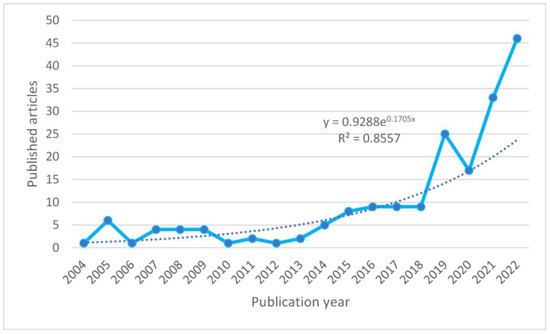
Figure 1.
Time series and trend of publications on ocean literacy. Blue line is time series and dotted lines is a trend.
The 192 total papers are the scientific output of 805 authors, and prolific authors were estimated using Lotka’s law [49] (Sq. root (805) ≈ 28.37). Thus, the authors with the greatest contribution to the production of this knowledge were estimated to be 29, but given the discrete count of papers, only 36 authors, who contributed three or more publications, were identified as prolific authors (see Figure 2).
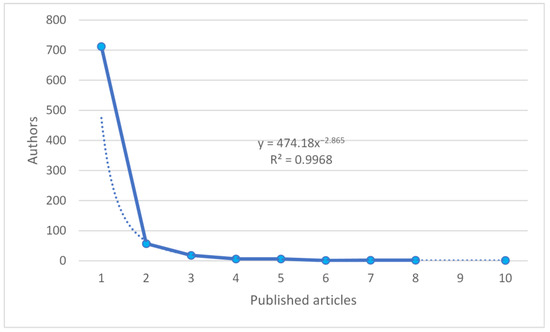
Figure 2.
Relationship between the scientific production level and authorship. Blue line is time series and dotted lines is a trend.
As shown in Figure 3, 25 prolific authors were grouped into five clusters: the first cluster is shown in yellow and includes the 4 authors with the highest production level; the second one is shown in blue and includes 5 prolific authors; the third one is shown in purple and consists of only 2 prolific authors; the fourth one is shown in red and includes 8 prolific authors; and finally, the fifth one is shown in green and includes 6 prolific authors.
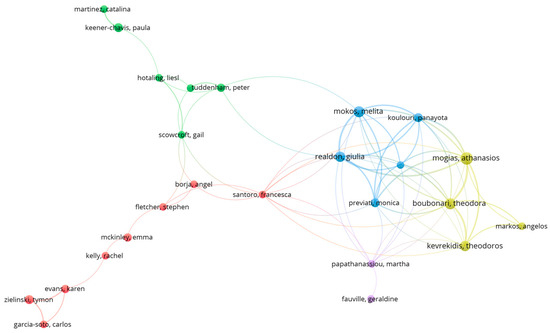
Figure 3.
Prolific co-authorship graph (colors indicate same author cluster).
Table 1 provides details for each of the clusters regarding its institutional and national affiliation.

Table 1.
Prolific author clusters and affiliations.
For an in-depth look at the interplay among authors, journals, and WoS categories of the ocean literacy studies, we incorporated the Hirsch index (h-index) as a citation impact weighting factor. Figure 4 shows the h-index interception, with 20 documents with 23 or more citations; Table 2 lists these papers. This means that these are the articles that are most recognized for this topic.
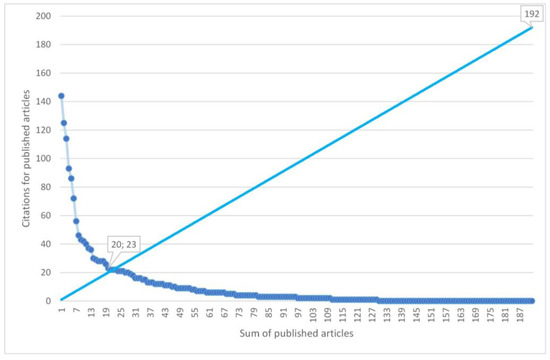
Figure 4.
h-Index estimation. Blue line is time series and dotted lines is a trend.

Table 2.
h-Index documents (23 or more citations).
Geographic co-authorships are illustrated in Figure 5, showing the international collaboration level among the countries producing knowledge on ocean literacy. Among them, it is interesting to see the variability in the citation levels reached, with Kenya (mean = 57 citations) and Canada (mean = 32 citations) standing out in the first places in academic recognition.
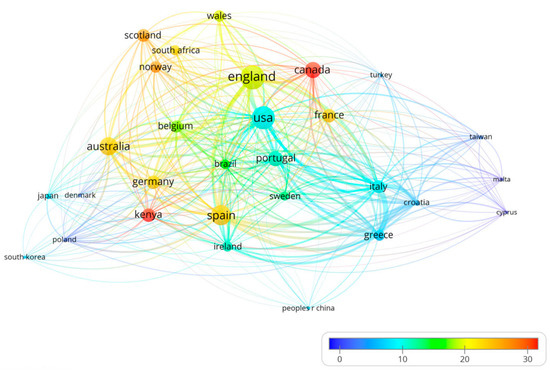
Figure 5.
National/territorial co-authorship graph.
The thematics of scientific production on ocean literacy created keyword clusters. For the 192 documents, a total of 374 Keywords Plus© were established. According to Zipf’s law, 17 more keywords were chosen considering as the estimator the square root of 374 (=19.33) with the highest frequency of use, between 7 and 24 occurrences (see Figure 6).
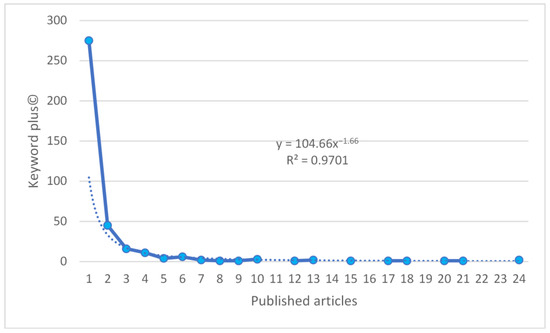
Figure 6.
Relationship between the level of scientific production and KWP frequency. Blue line is time series and dotted lines is a trend.
Thus, the Keywords Plus set generated three clusters: blue, focused on knowledge, perception, climate change, and citizenship (knowledge and citizen perception of climate change in relation to the oceans); green, with respect to biodiversity, management, conservation, and benefits (benefits of biodiversity management and ocean conservation); and red, associated with education, marine, sciences, attitudes, awareness, and behavior (ocean education and its relation to behavior, attitudes, and awareness of the oceans). It is important to highlight that the connection level between the three clusters was not so dense (see Figure 7).
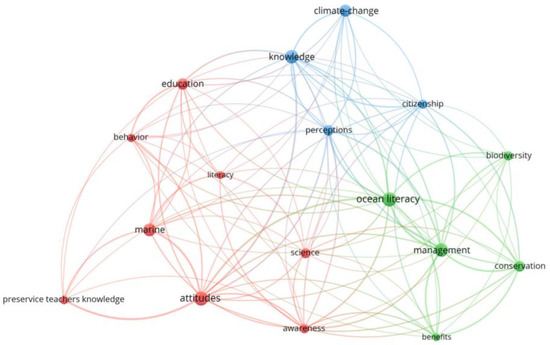
Figure 7.
Keywords Plus© co-occurrence graph. Nodes of the same color form an thematic cluster.
Table 3 shows the estimation of Bradford’s areas, with four journals standing out for their number (in parentheses the number of documents published and the WoS indexing category are indicated): Frontiers in Marine Science (32; Marine & Freshwater Biology), Mediterranean Marine Science (15; Marine & Freshwater Biology), Marine Policy (9; Environmental Studies, and International Relations), and Sustainability (9; Environmental Sciences, Environmental Studies, and Green & Sustainable Science & Technology). In the case of Frontiers in Marine Science, it is also relevant to note that it is a first-quartile (Q1) journal.

Table 3.
Bradford’s zones.
4. Discussion
Our bibliometric study found several findings that stand out compared with other studies of the same nature. The first is to point out that the scientific production from the years 2004 to 2019 was lower than that from 2020 to March 2023, allowing us to demonstrate the relevance of carrying out new studies during limited periods due to their exponential growth. On the other hand, our study found more specific topics, such as preservice teachers’ knowledge, biodiversity, and conservation, than previous studies, such as that by the authors Costa et al. [74], “Bibliometric analysis of ocean literacy: An underrated term in the scientific literature”. On the other hand, the quantity of scientific production per country differed in both studies. While, in our study, the countries with the highest production were the United States, the United Kingdom, and Portugal, in Costa and Caldeira’s study, Canada was considered one of the three countries with the highest production. In turn, these differences were confirmed when comparing another bibliometric study by the authors Paredes-Coral et al. [76], “Mapping Global Research on Ocean Literacy: Implications for Science, Policy, and the Blue Economy”, where there were differences in both the scientific production of countries and the topics found. Other studies used bibliometrix [77], and BibExcel and Pajek [78] software, whereas our study used four laws, a bibliometric indicator, and VOSviewer software. Undoubtedly, one of the factors that could explain these differences is the high scientific production in recent years changing the physiognomy of scientific production, reaffirming the contribution of this research by updating the findings of previous studies.
5. Conclusions
This bibliometric study on ocean literacy concludes that the scientific research output of researchers has grown at an exponential rate (R2 ≈ 86%), which has allowed 805 authors to build a substantial knowledge base on ocean literacy. However, of the total authors, according to Lotka’s law, only 36 authors were estimated to be prolific, contributing three or more publications on the topic under study and forming five clusters, with the production level of 4 researchers affiliated with organizations in Greece standing out. Then, the Hirsch index (h-index) as a citation impact weighting factor determined that 20 of 192 articles had 20 or more citations.
Regarding Keywords Plus, three thematic clusters were generated on ocean education focused on behavior and awareness, public commitment to climate change effects, and resource management policies related to conservation and its benefits for biodiversity. On the other hand, Bradford’s law identified four journals that accounted for a third of the published articles, where the journal Frontiers in Marine Science was the one with the highest concentration, with 32 documents being indexed in the category of WOS Marine & Freshwater Biology (Q1). This was followed by the journals Mediterranean Marine Science (with 15 papers being indexed in Marine & Freshwater Biology), Marine Policy (with 9 papers being indexed in Environmental Studies and International Relations), and Sustainability (with 9 papers being indexed in Environmental Sciences, Environmental Studies, and Green & Sustainable Science & Technology).
An important limitation we found in this research was to have identified a scarce number of specific publications on ocean literacy bibliometric research [74,76], which limits direct scientific discussions. Finally, as future research lines, we recommend further investigation of specific aspects related to ocean literacy with a thematic orientation [47] and to demonstrate connections among blue environment domains with comparative studies.
Supplementary Materials
The following supporting information can be downloaded at: https://www.mdpi.com/article/10.3390/w15112095/s1, Table S1: dataOL192.xlsx and dataOL192.txt (for VOSviewer).
Author Contributions
Conceptualization, A.V.-M., G.S.-S., M.T.-A. and N.C.-B.; methodology, A.V.-M. and G.S.-S.; formal analysis, A.V.-M., G.S.-S. and N.C.-B.; writing—original draft preparation, A.V.-M., C.C.-O., D.C., G.S.-S., M.T.-A. and N.C.-B.; writing—review and editing, A.V.-M., G.S.-S. and N.C.-B.; supervision, A.V.-M.; project administration, G.S.-S.; funding acquisition, A.V.-M., C.C.-O., D.C., G.S.-S., M.T.-A. and N.C.-B. All authors have read and agreed to the published version of the manuscript.
Funding
The Article Processing Charge was partially funded by Universidad Católica de la Santísima Concepción (code: APC2023). Additionally, the publication fee was partially financed through the Publication Incentive Fund, 2023, by Universidad Autónoma de Chile, (code: CC456001), Universidad Andres Bello (code: CC21500), Universidad de Las Americas (code: APC2023), Universidad Gabriela Mistral (code: APC2023), Universidad de Santiago de Chile (code: APC2023), and Universidad Tecnológica Metropolitana (code: APC2023).
Data Availability Statement
The analyzed dataset has been included as Supplementary Materials.
Conflicts of Interest
The authors declare no conflict of interest.
References
- McKinley, E.; Burdon, D.; Shellock, R.J. The evolution of ocean literacy: A new framework for the United Nations Ocean Decade and beyond. Mar. Pollut. Bull. 2023, 186, 114467. [Google Scholar] [CrossRef] [PubMed]
- Winks, L.; Ward, M.; Zilch, J.; Woodley, E. Residential marine field-course impacts on ocean literacy. Environ. Educ. Res. 2020, 26, 969–988. [Google Scholar] [CrossRef]
- Kelly, R.; Evans, K.; Alexander, K.; Bettiol, S.; Corney, S.; Cullen-Knox, C.; Cvitanovic, C.; de Salas, K.; Emad, G.R.; Fullbrook, L.; et al. Connecting to the oceans: Supporting ocean literacy and public engagement. Rev. Fish Biol. Fish. 2022, 32, 123–143. [Google Scholar] [CrossRef] [PubMed]
- Pazoto, C.; Duarte, M.; Silva, E. Education and the marine environmental issue: A historical review of research fields and the popularization on conservation and management of the sea and ocean in Brazil. J. Environ. Educ. 2023, 54, 99–113. [Google Scholar] [CrossRef]
- Visbeck, M.; Kronfeld-Goharani, U.; Neumann, B.; Rickels, W.; Schmidt, J.; van Doorn, E.; Matz-Lück, N.; Ott, K.; Quaas, M.F. Securing blue wealth: The need for a special sustainable development goal for the ocean and coasts. Mar. Policy 2014, 48, 184–191. [Google Scholar] [CrossRef]
- Fox, N.; Marshall, J.; Dankel, D.J. Ocean Literacy and Surfing: Understanding How Interactions in Coastal Ecosystems Inform Blue Space User's Awareness of the Ocean. Int. J. Environ. Res. Public Health 2021, 18, 5819. [Google Scholar] [CrossRef]
- Koulouri, P.; Mogias, A.; Mokos, M.; Cheimonopoulou, M.; Realdon, G.; Boubonari, T.; Previati, M.; Formoso, A.T.; Kideys, A.E.; Hassaan, M.A.; et al. Ocean Literacy across the Mediterranean Sea basin: Evaluating Middle School Students' Knowledge, Attitudes, and Behaviour towards Ocean Sciences Issues. Mediterr. Mar. Sci. 2022, 23, 289–301. [Google Scholar] [CrossRef]
- Gelcich, S.; Buckley, P.; Pinnegar, J.K.; Chilvers, J.; Lorenzoni, I.; Terry, G.; Guerrero, M.; Castilla, J.C.; Valdebenito, A.; Duarte, C.M. Public awareness, concerns, and priorities about anthropogenic impacts on marine environments. Proc. Natl. Acad. Sci. USA 2014, 111, 15042–15047. [Google Scholar] [CrossRef]
- Bettencourt, S.; Costa, S.; Caeiro, S. Marine litter: A review of educative interventions. Mar. Pollut. Bull. 2021, 168, 112446. [Google Scholar] [CrossRef]
- McKinley, E.; Acott, T.; Yates, K.L. Marine social sciences: Looking towards a sustainable future. Environ. Sci. Policy 2020, 108, 85–92. [Google Scholar] [CrossRef]
- McKinley, E.; Kelly, R.; Mackay, M.; Shellock, R.; Cvitanovic, C.; van Putten, I. Development and expansion in the marine social sciences: Insights from the global community. iScience 2022, 25, 104735. [Google Scholar] [CrossRef]
- Claudet, J.; Bopp, L.; Cheung, W.W.; Devillers, R.; Escobar-Briones, E.; Haugan, P.; Heymans, J.J.; Masson-Delmotte, V.; Matz-Luck, N.; Miloslavich, P.; et al. A Roadmap for Using the UN Decade of Ocean Science for Sustainable Development in Support of Science, Policy, and Action. One Earth 2020, 2, 34–42. [Google Scholar] [CrossRef]
- Koenigstein, S.; Hentschel, L.H.; Heel, L.C.; Drinkorn, C. A game-based education approach for sustainable ocean development. ICES. J. Mar. Sci. 2020, 77, 1629–1638. [Google Scholar] [CrossRef]
- Kelly, R.; Fleming, A.; Pecl, G.T.; Richter, A.; Bonn, A. Social license through citizen science: A tool for marine conservation. Ecol. Soc. 2019, 24, 16. [Google Scholar] [CrossRef]
- Ferreira, J.C.; Monteiro, R.; Vasconcelos, L.; Duarte, C.M.; Ferreira, F.; Santos, E. Perception of Citizens Regarding Marine Litter Impacts: Collaborative Methodologies in Island Fishing Communities of Cape Verde. J. Mar. Sci. Eng. 2021, 9, 306. [Google Scholar] [CrossRef]
- Leitao, R.; Maguire, M.; Turner, S.; Guimaraes, L. A systematic evaluation of game elements effects on students' motivation. Educ. Inf. Technol. 2022, 27, 1081–1103. [Google Scholar] [CrossRef]
- Lucrezi, S.; Milanese, M.; Danovaro, R.; Cerrano, C. ‘Generation Nemo’: Motivations, satisfaction and career goals of marine biology students. J. Biol. Educ. 2018, 52, 391–405. [Google Scholar] [CrossRef]
- Pazoto, C.E.; Silva, E.P.; Andrade, L.A.; del Favero, J.M.; Alo, C.F.; Duarte, M.R. Ocean Literacy, formal education, and governance: A diagnosis of Brazilian school curricula as a strategy to guide actions during the Ocean Decade and beyond. Ocean Coast. Res. 2021, 69, 21008cep. [Google Scholar] [CrossRef]
- Devenport, E.; Brooker, E.; Brooker, A.; Leakey, C. Insights and recommendations for involving young people in decision making for the marine environment. Mar. Policy 2021, 124, 104312. [Google Scholar] [CrossRef]
- Lotze, H.K.; Guest, H.; O’Leary, J.; Tuda, A.; Wallace, D. Public perceptions of marine threats and protection from around the world. Ocean Coast. Manag. 2018, 152, 14–22. [Google Scholar] [CrossRef]
- Pon, J.P.; Becherucci, M.E.; Paterlini, C.A.; Adrogue, A.Q.; Castano, M.V.; Zumpano, F.; Garcia, G.O. Perception, knowledge and attitudes towards environmental issues and management among coastal users of the most important beach destination in Argentina. Ocean Coast. Manag. 2022, 220, 106070. [Google Scholar] [CrossRef]
- Ankamah-Yeboah, I.; Xuan, B.B.; Hynes, S.; Armstrong, C.W. Public Perceptions of Deep-Sea Environment: Evidence from Scotland and Norway. Front. Mar. Sci. 2020, 7, 137. [Google Scholar] [CrossRef]
- Heck, N.; Petersen, K.L.; Potts, D.C.; Haddad, B.; Paytan, A. Predictors of coastal stakeholders' knowledge about seawater desalination impacts on marine ecosystems. Sci. Total Environ. 2018, 639, 785–792. [Google Scholar] [CrossRef] [PubMed]
- Zunino, S.; Canu, D.M.; Marangon, F.; Troiano, S. Cultural Ecosystem Services Provided by Coralligenous Assemblages and Posidonia oceanica in the Italian Seas. Front. Mar. Sci. 2020, 6, 823. [Google Scholar] [CrossRef]
- Albayrak, T.; Caber, M.; Cater, C. Mass tourism underwater: A segmentation approach to motivations of scuba diving holiday tourists. Tour. Geogr. 2021, 23, 985–1000. [Google Scholar] [CrossRef]
- McAfee, D.; Drew, G.; Connell, S.D. Recentering the role of marine restoration science to bolster community stewardship. Earth Syst. Gov. 2022, 13, 100149. [Google Scholar] [CrossRef]
- Fox, H.K.; Swearingen, T.C.; Molina, A.C.; Kennedy, C.M. Oregon recreational fishers' knowledge, support, and perceived impacts of marine reserves. Ocean Coast. Manag. 2022, 225, 106241. [Google Scholar] [CrossRef]
- Stoll-Kleemann, S. Feasible Options for Behavior Change Toward More Effective Ocean Literacy: A Systematic Review. Front. Mar. Sci. 2019, 6, 273. [Google Scholar] [CrossRef]
- Kasten, P.; Jenkins, S.R.; Christofoletti, R.A. Participatory Monitoring-A Citizen Science Approach for Coastal Environments. Front. Mar. Sci. 2021, 8, 681969. [Google Scholar] [CrossRef]
- Laffoley, D.; Baxter, J.M.; Amon, D.J.; Claudet, J.; Hall-Spencer, J.M.; Grorud-Colvert, K.; Levin, L.A.; Reid, P.C.; Rogers, A.D.; Taylor, M.L.; et al. Evolving the narrative for protecting a rapidly changing ocean, post-COVID-19. Aquat. Conserv.-Mar. Freshw. Ecosyst. 2021, 31, 1512–1534. [Google Scholar] [CrossRef]
- Evans, K.; Chiba, S.; Bebianno, M.J.; Garcia-Soto, C.; Ojaveer, H.; Park, C.; Ruwa, R.; Simcook, A.J.; Vu, C.T.; Zielinski, T. The Global Integrated World Ocean Assessment: Linking Observations to Science and Policy Across Multiple Scales. Front. Mar. Sci. 2019, 6, 298. [Google Scholar] [CrossRef]
- Leitao, R.; Maguire, M.; Turner, S.; Arenas, F.; Guimaraes, L. Ocean literacy gamified: A systematic evaluation of the effect of game elements on students' learning experience. Environ. Educ. Res. 2022, 28, 276–294. [Google Scholar] [CrossRef]
- Salazar, J.; Dominguez-Carrio, C.; Gili, J.M.; Ambroso, S.; Grinyo, J.; Vendrell-Simon, B. Building a New Ocean Literacy Approach Based on a Simulated Dive in a Submarine: A Multisensory Workshop to Bring the Deep Sea Closer to People. Front. Mar. Sci. 2019, 6, 576. [Google Scholar] [CrossRef]
- McHugh, M.; McCauley, V.; Davison, K.; Raine, R.; Grehan, A. Anchoring ocean literacy: Participatory iBook design within secondary science classrooms. Technol. Pedagag. Educ. 2020, 29, 89–107. [Google Scholar] [CrossRef]
- Chang, C.C.; Hirenkumar, T.C.; Wu, C.K. The Concept of Ocean Sustainability in Formal Education-Comparative Ocean Literacy Coverage Analysis of the Educational Standards of India and the USA. Sustainability 2021, 13, 4314. [Google Scholar] [CrossRef]
- Pazoto, C.E.; Silva, E.P.; Duarte, M.R. Ocean literacy in Brazilian school curricula: An opportunity to improve coastal management and address coastal risks? Ocean Coast. Manag. 2022, 219, 106047. [Google Scholar] [CrossRef]
- Realdon, G.; Mogias, A.; Fabris, S.; Candussio, G.; Invernizzi, C.; Paris, E. Assessing Ocean Literacy in a sample of Italian primary and middle school students. Rend. Online Soc. Geol. Ital. 2019, 49, 107–112. [Google Scholar] [CrossRef]
- Lin, Y.L.; Wu, L.Y.; Tsai, L.T.; Chang, C.C. The Beginning of Marine Sustainability: Preliminary Results of Measuring Students’ Marine Knowledge and Ocean Literacy. Sustainability 2020, 12, 7115. [Google Scholar] [CrossRef]
- Mogias, A.; Boubonari, T.; Realdon, G.; Previati, M.; Mokos, M.; Koulouri, P.; Cheimonopoulou, M.T. Evaluating Ocean Literacy of Elementary School Students: Preliminary Results of a Cross-Cultural Study in the Mediterranean Region. Front. Mar. Sci. 2019, 6, 396. [Google Scholar] [CrossRef]
- Mogias, A.; Boubonari, T.; Markos, A.; Kevrekidis, T. Greek Pre-Service Teachers’ Knowledge of Ocean Sciences Issues and Attitudes Toward Ocean Stewardship. J. Environ. Educ. 2015, 46, 251–270. [Google Scholar] [CrossRef]
- Ahmad-Kamil, E.I.; Zakaria, S.Z.S.; Othman, M. What Teachers Should Know for Effective Marine Litter Education: A Scoping Review. Sustainability 2022, 14, 4308. [Google Scholar] [CrossRef]
- Mioni, E. Contribution to the Special Issue: Ocean Literacy across the Mediterranean Sea region Percorsi nel Blu (Blue Paths): A long-lasting project to integrate ocean literacy and marine citizen science into school curricula. Mediterr. Mar. Sci. 2022, 23, 405–416. [Google Scholar] [CrossRef]
- Clarivate. Web of Science. Available online: https://www.webofknowledge.com/ (accessed on 12 October 2022).
- Price, D. A general theory of bibliometric and other cumulative advantage processes. J. Assoc. Inf. Sci. 1976, 27, 292–306. [Google Scholar] [CrossRef]
- Dobrov, G.M.; Randolph, R.H.; Rauch, W.D. New options for team research via international computer networks. Scientometrics 1979, 1, 387–404. [Google Scholar] [CrossRef]
- Vega-Munoz, A.; Salazar-Sepulveda, G.; Contreras-Barraza, N.; Araya-Silva, L. Scientific Mapping of Coastal Governance: Global Benchmarks and Trends. J. Mar. Sci. Eng. 2022, 10, 751. [Google Scholar] [CrossRef]
- Vega-Muñoz, A.; Salazar-Sepúlveda, G.; Contreras-Barraza, N. Identifying the Blue Economy Global Epistemic Community. Water 2021, 13, 3234. [Google Scholar] [CrossRef]
- Vega-Muñoz, A.; Arjona-Fuentes, J.M.; Ariza-Montes, A.; Han, H.; Law, R. In search of “a research front” in cruise tourism studies. Int. J. Hosp. Manag. 2019, 85, 102353. [Google Scholar] [CrossRef]
- Lotka, A.J. The frequency distribution of scientific productivity. J. Wash. Acad. Sci. 1926, 16, 317–321. [Google Scholar]
- López-Medina, T.; Mendoza-Ávila, I.; Contreras-Barraza, N.; Salazar-Sepúlveda, G.; Vega-Muñoz, A. Bibliometric Mapping of Research Trends on Financial Behavior for Sustainability. Sustainability 2022, 14, 117. [Google Scholar] [CrossRef]
- Sianes, A.; Vega-Muñoz, A.; Tirado-Valencia, P.; Ariza-Montes, A. Impact of the Sustainable Development Goals on the academic research agenda. A scientometric analysis. PLoS ONE 2022, 17, e0265409. [Google Scholar] [CrossRef] [PubMed]
- Hirsch, J.E. An index to quantify an individual’s scientific research output. Proc. Natl. Acad. Sci. USA 2005, 102, 16569–16572. [Google Scholar] [CrossRef] [PubMed]
- Crespo, N.; Simoes, N. Publication Performance Through the Lens of the h-index: How Can We Solve the Problem of the Ties? Soc. Sci. Q. 2019, 100, 2495–2506. [Google Scholar] [CrossRef]
- Bulik, S. Book use as a Bradford-Zipf Phenomenon. Coll. Res. Libr. 1978, 39, 215–219. [Google Scholar] [CrossRef]
- Morse, P.M.; Leimkuhler, F.F. Technical note—Exact solution for the Bradford distribution and its use in modeling informational data. Oper. Res. 1979, 27, 187–198. [Google Scholar] [CrossRef]
- Kumar, S. Application of Bradford’s law to human-computer interaction research literature. DESIDOC. J. Libr. Inf. Technol. 2014, 34, 223–231. [Google Scholar]
- Contreras-Barraza, N.; Espinosa-Cristia, J.F.; Salazar-Sepulveda, G.; Vega-Muñoz, A.; Ariza-Montes, A. A Scientometric Systematic Review of Entrepreneurial Wellbeing Knowledge Production. Front. Psychol. 2021, 12, 641465. [Google Scholar] [CrossRef]
- Zipf, G.K. Selected Studies of the Principle of Relative Frequency in Language; Harvard University Press: Cambridge, MA, USA, 1932. [Google Scholar]
- Mikhaylov, A.; Mikhaylova, A.; Hvaley, D. Knowledge Hubs of Russia: Bibliometric Mapping of Research Activity. J. Sci. Res. 2020, 9, 1–10. [Google Scholar] [CrossRef]
- Moravcsik, M.J. Applied scientometrics: An assessment methodology for developing countries. Scientometrics 1985, 7, 165–176. [Google Scholar] [CrossRef]
- Zhang, D.; Xu, J.; Zhang, Y.; Wang, J.; He, S.; Zhou, X. Study on sustainable urbanization literature based on Web of Science, scopus, and China national knowledge infrastructure: A scientometric analysis in CiteSpace. J. Clean. Prod. 2020, 264, 121537. [Google Scholar] [CrossRef]
- Van Eck, N.J.; Waltman, L. Software survey: VOSviewer, a computer program for bibliometric mapping. Scientometrics 2010, 84, 523–538. [Google Scholar] [CrossRef]
- Steel, B.S.; Smith, C.; Opsommer, L.; Curiel, S.; Warner-Steel, R. Public ocean literacy in the United States. Ocean Coast. Manag. 2005, 48, 97–114. [Google Scholar] [CrossRef]
- Jefferson, R.; McKinley, E.; Capstick, S.; Fletcher, S.; Griffin, H.; Milanese, M. Understanding audiences: Making public perceptions research matter to marine conservation. Ocean Coast. Manag. 2015, 115, 61–70. [Google Scholar] [CrossRef]
- Guest, H.; Lotze, H.K.; Wallace, D. Youth and the sea: Ocean literacy in Nova Scotia, Canada. Mar. Policy 2015, 58, 98–107. [Google Scholar] [CrossRef]
- Gutierrez, A.; Thornton, T.F. Can Consumers Understand Sustainability through Seafood Eco-Labels? A U.S. and UK Case Study. Sustainability 2014, 6, 8195–8217. [Google Scholar] [CrossRef]
- Fleming, L.E.; McDonough, N.; Austen, M.; Mee, L.; Moore, M.; Hess, P.; Depledge, M.H.; White, M.; Philippart, K.; Bradbrook, P.; et al. Oceans and Human Health: A rising tide of challenges and opportunities for Europe. Mar. Environ. Res. 2014, 99, 16–19. [Google Scholar] [CrossRef] [PubMed]
- Boubonari, T.; Markos, A.; Kevrekidis, T. Greek Pre-Service Teachers’ Knowledge, Attitudes, and Environmental Behavior Toward Marine Pollution. J. Environ. Educ. 2013, 44, 232–251. [Google Scholar] [CrossRef]
- Fauville, G.; Strang, C.; Cannady, M.A.; Chen, Y.F. Development of the International Ocean Literacy Survey: Measuring knowledge across the world. Environ. Educ. Res. 2019, 25, 238–263. [Google Scholar] [CrossRef]
- Hynes, S.; Norton, D.; Corless, R. Investigating societal attitudes towards the marine environment of Ireland. Mar. Policy 2014, 47, 57–65. [Google Scholar] [CrossRef]
- Perry, E.E.; Needham, M.D.; Cramer, L.A.; Rosenberger, R.S. Coastal resident knowledge of new marine reserves in Oregon: The impact of proximity and attachment. Ocean Coast. Manag. 2014, 95, 107–116. [Google Scholar] [CrossRef]
- Fauville, G.; Dupont, S.; von Thun, S.; Lundin, J. Can Facebook be used to increase scientific literacy? A case study of the Monterey Bay Aquarium Research Institute Facebook page and ocean literacy. Comput. Educ. 2015, 82, 60–73. [Google Scholar] [CrossRef]
- Hawkins, J.P.; O’Leary, B.C.; Bassett, N.; Peters, H.; Rakowski, S.; Reeve, G.; Roberts, C.M. Public awareness and attitudes towards marine protection in the United Kingdom. Mar. Pollut. Bull. 2016, 111, 231–236. [Google Scholar] [CrossRef] [PubMed]
- Costa, S.; Caldeira, R. Bibliometric analysis of ocean literacy: An underrated term in the scientific literature. Mar. Policy 2018, 87, 149–157. [Google Scholar] [CrossRef]
- Mea, M.; Newton, A.; Uyarra, M.C.; Alonso, C.; Borja, A. From Science to Policy and Society: Enhancing the Effectiveness of Communication. Front. Mar. Sci. 2016, 3, 168. [Google Scholar] [CrossRef]
- Paredes-Coral, E.; Mokos, M.; Vanreusel Ann, D. Mapping Global Research on Ocean Literacy: Implications for Science, Policy, and the Blue Economy. Front. Mar. Sci. 2021, 8, 648492. [Google Scholar] [CrossRef]
- Zhang, J.; Zhang, Y.; Xie, Z. Using technology to promote the development of health science libraries in China. Health Info. Libr. J. 2023, 40, 109–113. [Google Scholar] [CrossRef]
- Costa, M.D.D.; Macreadie, P.I. The Evolution of Blue Carbon Science. Wetlands 2022, 42, 109. [Google Scholar] [CrossRef]
Disclaimer/Publisher’s Note: The statements, opinions and data contained in all publications are solely those of the individual author(s) and contributor(s) and not of MDPI and/or the editor(s). MDPI and/or the editor(s) disclaim responsibility for any injury to people or property resulting from any ideas, methods, instructions or products referred to in the content. |
© 2023 by the authors. Licensee MDPI, Basel, Switzerland. This article is an open access article distributed under the terms and conditions of the Creative Commons Attribution (CC BY) license (https://creativecommons.org/licenses/by/4.0/).